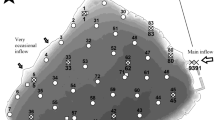Abstract
The response of four benthic cyclopoid copepods,Acanthocyclops viridis (Megacyclops viridis) (Jurine, 1820),Macrocyclops albidus (Jurine),Eucyclops agilis (Koch, Sars) (Eucyclops serrulatus) (Fischer, 1851) andParacyclops fimbriatus (Fischer), to hypoxia and anoxia was investigated. All of these species died within six hours when confronted by totally anoxic conditions, but all survived four days at oxygen saturation levels as low as 25%. Males succumbed to the effects of anoxia more rapidly than the larger females of each species, and larger species survived for shorter periods than smaller species. In artificially stratified columns, where the lower layer was anoxic, all four species displayed an upward migratory response towards oxygenated conditions. Where the artificial hypolimnion was hypoxic, however, the migratory response was not observed. The results suggest that some benthic copepods cope with seasonal anoxia in eutrophic stratified lakes by migration rather than the various physiological adaptations shown by planktonic and semi-planktonic species.
Similar content being viewed by others
References
Adalsteinsson, H., 1979. Seasonal variation and habitat distribution of benthic Crustacea in Lake Myvatn in 1974. Oikos 32: 195–201.
Andrews, T. F., 1953. Seasonal variations in relative abundance ofCyclops vernalis Fischer,Cyclops bicuspidatus Claus andMesocyclops leuckarti (Claus) in western Lake Erie, from July 1946 to May 1948. Ohio J. Sci. 33: 91–100.
Brand, T. von, 1946. Anaerobiasis in invertebrates. Biodynamica 4: 99–101.
Chaston, I., 1969. Anaerobiasis inCyclops varicans. Limnol. Oceanogr. 14: 298–301.
Clark, G. L., 1934. Factors affecting the vertical distribution of copepods. Ecol. Monogr. 4: 530–540.
Cole, G. A., 1955. An ecological study of the microbenthic fauna of two Minnesota lakes. Am. Midl. Nat. 53: 213–230
Cushing, D. H., 1951. The vertical migration of planktonic Crustacea. Biol. Rev. 26: 158–192.
Fryer, G., 1957. The food of some freshwater cyclopoid copepods and its ecological significance. J. anim. Ecol. 26: 263–286.
Fryer, G. & W. P. Smyly, 1954. Some remarks on the resting stages of some freshwater cyclopoid and harpacticoid copepods. Ann. Mag. nat. Hist. 12: 65–72.
George, D. G., 1976. Life cycle and production ofCyclops vicinus in a shallow eutrophic reservoir. Oikos. 27: 101–110.
Holopainen, I. J. & L. Paasivirta, 1977. Abundance and biomass of the microbenthos in the oligotrophic and mesohumic lake Paajarvi, Southern Finland. Ann. zool. fenn. 14: 124–134.
Laybourn-Parry, J. & S. Tinson, 1985. Respiratory studies on two benthic copepodsAcanthocyclops viridis andEucyclops agilis at environmental temperatures. Oecologia (Berl.) 65: 566–572.
Papinska, K. & K. Prejs, 1979. Crustaceans of the near-bottom water and bottom sediments in 24 Masurian Lakes with special consideration to cyclopoid copepods. Ekol. pol. 27: 603–624.
Rylov, V. M., 1948. Freshwater Cyclopoida, Fauna of the USSR, 3. Crustacea. Israel Progm. scient. Transl. Jerusalem 1963. Zool. Inst. Acad. scient. USSR New Ser. 35, V 1–160
Smyly, W. J. P., 1957. Distribution and seasonal abundance of Entomostraca in moorland ponds near Windermere. Hydrobiologia 11: 59–72.
Smyly, W. J. P., 1962. Laboratory experiments with stage V copepodites of the freshwater copepod,Cyclops leuckarti Claus, from Windermere and Esthwaite Water. Crustaceana 4: 273–280.
Smyly, W. J. P., 1968. Observations on the planktonic and profundal Crustacea of the lakes in the English Lake District. J. anim. Ecol. 37: 693–708.
Smyly, W. J. P., 1973. Bionomics ofCyclops strenuus abyssorum Sars (Copepoda: Cyclopoida) Oecologia (Berl.) 11: 163–186.
Smyly, W. J. P., 1978. The crustacean zooplankton of Grasmere before and after a change in sewage effluent treatment. Int. Revue ges. Hydrobiol. 63: 389–403.
Wierzbicka, M., 1962. On the resting stage and mode of life of some species of Cyclopoida. Pol. Arch. Hydrobiol. 10: 215–229.
Author information
Authors and Affiliations
Rights and permissions
About this article
Cite this article
Tinson, S., Laybourn-Parry, J. The behavioural responses and tolerance of freshwater benthic cyclopoid copepods to hypoxia and anoxia. Hydrobiologia 127, 257–263 (1985). https://doi.org/10.1007/BF00024230
Issue Date:
DOI: https://doi.org/10.1007/BF00024230



